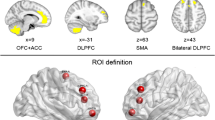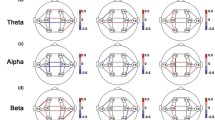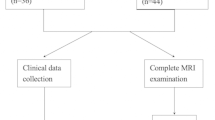Abstract
Although evidence has shown that the prevalence rates of Internet gaming disorder (IGD) differ between males and females, few studies have examined whether such sex differences extend to brain function. This study aimed to explore the sex differences in resting-state cerebral activity alterations in IGD. Thirty male participants with IGD (IGDm), 23 female participants with IGD (IGDf), and 30 male and 22 female age-matched healthy controls (HC) underwent resting-state functional MRI. Maps of the amplitude of low-frequency fluctuation (ALFF) and functional connectivity (FC) were constructed. A two-factor ANCOVA model was performed, with sex and diagnosis as the between-subject factors. Then, post hoc pair-wise comparisons were performed using two-sample t-tests within the interaction masks. The Barratt Impulsiveness Scale-11 (BIS-11) was used to assess the behavioral inhibition function. We found that the ALFF values in the orbital part of the left superior frontal gyrus (SFG) were lower in IGDm than in HCm, which were negatively correlated with BIS-11 scores. IGDm also demonstrated lower connectivity between the orbital part of the left SFG and the posterior cingulate cortex (PCC), the right angular gyrus, and the right dorsolateral prefrontal cortex than HCm. Furthermore, IGDm had lower seed connectivity between the orbital part of the left SFG and the PCC than ICDf. Our findings suggest that (1) the altered ALFF values in the orbital part of the left SFG represent a clinically relevant biomarker for the behavioral inhibition function of IGDm; (2) IGD may interact with sex-specific patterns of FC in male and female subjects.



Similar content being viewed by others
References
Argyriou, E., Davison, C. B., & Lee, T. T. C. (2017). Response inhibition and internet gaming disorder: A meta-analysis. Addictive Behaviors, 71, 54–60. https://doi.org/10.1016/j.addbeh.2017.02.026.
Bayless, D. W., & Daniel, J. M. (2015). Sex differences in myelin-associated protein levels within and density of projections between the orbital frontal cortex and dorsal striatum of adult rats: Implications for inhibitory control. Neuroscience, 300, 286–296. https://doi.org/10.1016/j.neuroscience.2015.05.029.
Beard, K. W., & Wolf, E. M. (2001). Modification in the proposed diagnostic criteria for internet addiction. Cyberpsychology & Behavior, 4(3), 377–383. https://doi.org/10.1089/109493101300210286.
Becker, J. B., McClellan, M., & Reed, B. G. (2016). Sociocultural context for sex differences in addiction. Addiction Biology, 21(5), 1052–1059. https://doi.org/10.1111/adb.12383.
Billieux, J., Chanal, J., Khazaal, Y., Rochat, L., Gay, P., Zullino, D., et al. (2011). Psychological predictors of problematic involvement in massively multiplayer online role-playing games: Illustration in a sample of male cybercafe players. Psychopathology, 44(3), 165–171. https://doi.org/10.1159/000322525.
Cahill, L. (2006). Why sex matters for neuroscience. Nature Reviews. Neuroscience, 7(6), 477–484. https://doi.org/10.1038/nrn1909.
Chen, X., Wang, Y., Zhou, Y., Sun, Y., Ding, W., Zhuang, Z., et al. (2014). Different resting-state functional connectivity alterations in smokers and nonsmokers with internet gaming addiction. BioMed Research International, 2014, 825787. https://doi.org/10.1155/2014/825787.
de Ruiter, M. B., Oosterlaan, J., Veltman, D. J., van den Brink, W., & Goudriaan, A. E. (2012). Similar hyporesponsiveness of the dorsomedial prefrontal cortex in problem gamblers and heavy smokers during an inhibitory control task. Drug and Alcohol Dependence, 121(1–2), 81–89. https://doi.org/10.1016/j.drugalcdep.2011.08.010.
DeVito, E. E., Meda, S. A., Jiantonio, R., Potenza, M. N., Krystal, J. H., & Pearlson, G. D. (2013). Neural correlates of impulsivity in healthy males and females with family histories of alcoholism. Neuropsychopharmacology, 38(10), 1854–1863. https://doi.org/10.1038/npp.2013.92.
Dieter, J., Hoffmann, S., Mier, D., Reinhard, I., Beutel, M., Vollstadt-Klein, S., et al. (2017). The role of emotional inhibitory control in specific internet addiction - an fMRI study. Behavioural Brain Research, 324, 1–14. https://doi.org/10.1016/j.bbr.2017.01.046.
Dong, G., Devito, E. E., Du, X., & Cui, Z. (2012). Impaired inhibitory control in 'internet addiction disorder': A functional magnetic resonance imaging study. Psychiatry Research, 203(2–3), 153–158. https://doi.org/10.1016/j.pscychresns.2012.02.001.
Dong, G., Li, H., Wang, L., & Potenza, M. N. (2017). The correlation between mood states and functional connectivity within the default mode network can differentiate internet gaming disorder from healthy controls. Progress in Neuro-Psychopharmacology & Biological Psychiatry, 77, 185–193. https://doi.org/10.1016/j.pnpbp.2017.04.016.
Dong, G., Wang, Z., Wang, Y., Du, X., & Potenza, M. N. (2018). Gender-related functional connectivity and craving during gaming and immediate abstinence during a mandatory break: Implications for development and progression of internet gaming disorder. Progress in Neuro-Psychopharmacology & Biological Psychiatry. https://doi.org/10.1016/j.pnpbp.2018.04.009.
Durkee, T., Kaess, M., Carli, V., Parzer, P., Wasserman, C., Floderus, B., et al. (2012). Prevalence of pathological internet use among adolescents in Europe: Demographic and social factors. Addiction, 107(12), 2210–2222. https://doi.org/10.1111/j.1360-0443.2012.03946.x.
Ernst, M., Pine, D. S., & Hardin, M. (2006). Triadic model of the neurobiology of motivated behavior in adolescence. Psychological Medicine, 36(3), 299–312. https://doi.org/10.1017/S0033291705005891.
Everitt, B. J., Hutcheson, D. M., Ersche, K. D., Pelloux, Y., Dalley, J. W., & Robbins, T. W. (2007). The orbital prefrontal cortex and drug addiction in laboratory animals and humans. Annals of the New York Academy of Sciences, 1121, 576–597. https://doi.org/10.1196/annals.1401.022.
Fattore, L., Melis, M., Fadda, P., & Fratta, W. (2014). Sex differences in addictive disorders. Frontiers in Neuroendocrinology, 35(3), 272–284. https://doi.org/10.1016/j.yfrne.2014.04.003.
Feng, Q., Chen, X., Sun, J., Zhou, Y., Sun, Y., Ding, W., et al. (2013). Voxel-level comparison of arterial spin-labeled perfusion magnetic resonance imaging in adolescents with internet gaming addiction. Behavioral and Brain Functions, 9(1), 33. https://doi.org/10.1186/1744-9081-9-33.
Franklin, T. R., Wetherill, R. R., Jagannathan, K., Johnson, B., Mumma, J., Hager, N., et al. (2014). The effects of chronic cigarette smoking on gray matter volume: Influence of sex. PLoS One, 9(8), e104102. https://doi.org/10.1371/journal.pone.0104102.
Giedd, J. N. (2004). Structural magnetic resonance imaging of the adolescent brain. Annals of the New York Academy of Sciences, 1021, 77–85. https://doi.org/10.1196/annals.1308.009.
Goldstein, R. Z., & Volkow, N. D. (2011). Dysfunction of the prefrontal cortex in addiction: Neuroimaging findings and clinical implications. Nature Reviews. Neuroscience, 12(11), 652–669. https://doi.org/10.1038/nrn3119.
Goldstein, J. M., Seidman, L. J., Horton, N. J., Makris, N., Kennedy, D. N., Caviness Jr., V. S., et al. (2001). Normal sexual dimorphism of the adult human brain assessed by in vivo magnetic resonance imaging. Cerebral Cortex, 11(6), 490–497.
Goudriaan, A. E., Lapauw, B., Ruige, J., Feyen, E., Kaufman, J. M., Brand, M., et al. (2010). The influence of high-normal testosterone levels on risk-taking in healthy males in a 1-week letrozole administration study. Psychoneuroendocrinology, 35(9), 1416–1421. https://doi.org/10.1016/j.psyneuen.2010.04.005.
Hu, Y., Salmeron, B. J., Gu, H., Stein, E. A., & Yang, Y. (2015). Impaired functional connectivity within and between frontostriatal circuits and its association with compulsive drug use and trait impulsivity in cocaine addiction. JAMA Psychiatry, 72(6), 584–592. https://doi.org/10.1001/jamapsychiatry.2015.1.
Ide, J. S., Zhornitsky, S., Hu, S., Zhang, S., Krystal, J. H., & Li, C. R. (2017). Sex differences in the interacting roles of impulsivity and positive alcohol expectancy in problem drinking: A structural brain imaging study. Neuroimage Clin, 14, 750–759. https://doi.org/10.1016/j.nicl.2017.03.015.
Jenkinson, M., Bannister, P., Brady, M., & Smith, S. (2002). Improved optimization for the robust and accurate linear registration and motion correction of brain images. Neuroimage, 17(2), 825–841.
Ko, C. H., Yen, J. Y., Yen, C. F., Chen, C. C., Yen, C. N., & Chen, S. H. (2005). Screening for internet addiction: An empirical study on cut-off points for the Chen internet addiction scale. The Kaohsiung Journal of Medical Sciences, 21(12), 545–551. https://doi.org/10.1016/s1607-551x(09)70206-2.
Ko, C. H., Liu, G. C., Hsiao, S., Yen, J. Y., Yang, M. J., Lin, W. C., et al. (2009). Brain activities associated with gaming urge of online gaming addiction. Journal of Psychiatric Research, 43(7), 739–747. https://doi.org/10.1016/j.jpsychires.2008.09.012.
Ko, C. H., Hsieh, T. J., Wang, P. W., Lin, W. C., Yen, C. F., Chen, C. S., et al. (2015). Altered gray matter density and disrupted functional connectivity of the amygdala in adults with internet gaming disorder. Progress in Neuro-Psychopharmacology & Biological Psychiatry, 57, 185–192. https://doi.org/10.1016/j.pnpbp.2014.11.003.
Kogachi, S., Chang, L., Alicata, D., Cunningham, E., & Ernst, T. (2017). Sex differences in impulsivity and brain morphometry in methamphetamine users. Brain Structure & Function, 222(1), 215–227. https://doi.org/10.1007/s00429-016-1212-2.
Kvamme, T. L., Schmidt, C., Strelchuk, D., Chang-Webb, Y. C., Baek, K., & Voon, V. (2016). Sexually dimorphic brain volume interaction in college-aged binge drinkers. Neuroimage Clin, 10, 310–317. https://doi.org/10.1016/j.nicl.2015.12.004.
Li, M., Chen, J., Li, N., & Li, X. (2014a). A twin study of problematic internet use: Its heritability and genetic association with effortful control. Twin Research and Human Genetics, 17(4), 279–287. https://doi.org/10.1017/thg.2014.32.
Li, Y., Qiao, L., Sun, J., Wei, D., Li, W., Qiu, J., et al. (2014b). Gender-specific neuroanatomical basis of behavioral inhibition/approach systems (BIS/BAS) in a large sample of young adults: A voxel-based morphometric investigation. Behavioural Brain Research, 274, 400–408. https://doi.org/10.1016/j.bbr.2014.08.041.
Li, W., Li, Y., Yang, W., Zhang, Q., Wei, D., Li, W., et al. (2015). Brain structures and functional connectivity associated with individual differences in internet tendency in healthy young adults. Neuropsychologia, 70, 134–144. https://doi.org/10.1016/j.neuropsychologia.2015.02.019.
Ma, N., Liu, Y., Fu, X. M., Li, N., Wang, C. X., Zhang, H., et al. (2011). Abnormal brain default-mode network functional connectivity in drug addicts. PLoS One, 6(1), e16560. https://doi.org/10.1371/journal.pone.0016560.
Mak, L. E., Minuzzi, L., MacQueen, G., Hall, G., Kennedy, S. H., & Milev, R. (2017). The default mode network in healthy individuals: A systematic review and meta-analysis. Brain Connectivity, 7(1), 25–33. https://doi.org/10.1089/brain.2016.0438.
Mehta, P. H., & Beer, J. (2010). Neural mechanisms of the testosterone-aggression relation: The role of orbitofrontal cortex. Journal of Cognitive Neuroscience, 22(10), 2357–2368. https://doi.org/10.1162/jocn.2009.21389.
Meng, Y., Deng, W., Wang, H., Guo, W., & Li, T. (2015). The prefrontal dysfunction in individuals with internet gaming disorder: A meta-analysis of functional magnetic resonance imaging studies. Addiction Biology, 20(4), 799–808. https://doi.org/10.1111/adb.12154.
Munno, D., Cappellin, F., Saroldi, M., Bechon, E., Guglielmucci, F., Passera, R., et al. (2017). Internet addiction disorder: Personality characteristics and risk of pathological overuse in adolescents. Psychiatry Research, 248, 1–5. https://doi.org/10.1016/j.psychres.2016.11.008.
Park, S. Y., Kim, S. M., Roh, S., Soh, M. A., Lee, S. H., Kim, H., et al. (2016). The effects of a virtual reality treatment program for online gaming addiction. Computer Methods and Programs in Biomedicine, 129, 99–108. https://doi.org/10.1016/j.cmpb.2016.01.015.
Patton, J. H., Stanford, M. S., & Barratt, E. S. (1995). Factor structure of the Barratt impulsiveness scale. Journal of Clinical Psychology, 51(6), 768–774.
Raznahan, A., Lee, Y., Stidd, R., Long, R., Greenstein, D., Clasen, L., et al. (2010). Longitudinally mapping the influence of sex and androgen signaling on the dynamics of human cortical maturation in adolescence. Proceedings of the National Academy of Sciences of the United States of America, 107(39), 16988–16993. https://doi.org/10.1073/pnas.1006025107.
Rehbein, F., Kleimann, M., & Mossle, T. (2010). Prevalence and risk factors of video game dependency in adolescence: Results of a German nationwide survey. Cyberpsychology, Behavior and Social Networking, 13(3), 269–277.
Seeley, W. W., Menon, V., Schatzberg, A. F., Keller, J., Glover, G. H., Kenna, H., et al. (2007). Dissociable intrinsic connectivity networks for salience processing and executive control. The Journal of Neuroscience, 27(9), 2349–2356. https://doi.org/10.1523/JNEUROSCI.5587-06.2007.
Shek, D. T., & Yu, L. (2016). Adolescent internet addiction in Hong Kong: Prevalence, change, and Correlates. Journal of Pediatric and Adolescent Gynecology, 29(1 Suppl), S22–S30. https://doi.org/10.1016/j.jpag.2015.10.005.
Shulman, E. P., Harden, K. P., Chein, J. M., & Steinberg, L. (2015). Sex differences in the developmental trajectories of impulse control and sensation-seeking from early adolescence to early adulthood. Journal of Youth and Adolescence, 44(1), 1–17. https://doi.org/10.1007/s10964-014-0116-9.
Stoltenberg, S. F., Batien, B. D., & Birgenheir, D. G. (2008). Does gender moderate associations among impulsivity and health-risk behaviors? Addictive Behaviors, 33(2), 252–265. https://doi.org/10.1016/j.addbeh.2007.09.004.
Tomasi, D., & Volkow, N. D. (2012). Aging and functional brain networks. Molecular Psychiatry, 17(5), 471–549–458. https://doi.org/10.1038/mp.2011.81.
Wang, H., Jin, C., Yuan, K., Shakir, T. M., Mao, C., Niu, X., et al. (2015). The alteration of gray matter volume and cognitive control in adolescents with internet gaming disorder. Frontiers in Behavioral Neuroscience, 9, 64. https://doi.org/10.3389/fnbeh.2015.00064.
Wang, L., Wu, L., Lin, X., Zhang, Y., Zhou, H., Du, X., et al. (2016). Dysfunctional default mode network and executive control network in people with internet gaming disorder: Independent component analysis under a probability discounting task. European Psychiatry, 34, 36–42. https://doi.org/10.1016/j.eurpsy.2016.01.2424.
Weinstein, A., Livny, A., & Weizman, A. (2017). New developments in brain research of internet and gaming disorder. Neuroscience and Biobehavioral Reviews, 75, 314–330. https://doi.org/10.1016/j.neubiorev.2017.01.040.
Yan, C. G., Cheung, B., Kelly, C., Colcombe, S., Craddock, R. C., Di Martino, A., et al. (2013). A comprehensive assessment of regional variation in the impact of head micromovements on functional connectomics. Neuroimage, 76, 183–201. https://doi.org/10.1016/j.neuroimage.2013.03.004.
Yuan, K., Qin, W., Wang, G., Zeng, F., Zhao, L., Yang, X., et al. (2011). Microstructure abnormalities in adolescents with internet addiction disorder. PLoS One, 6(6), e20708. https://doi.org/10.1371/journal.pone.0020708.
Yuan, K., Jin, C., Cheng, P., Yang, X., Dong, T., Bi, Y., et al. (2013). Amplitude of low frequency fluctuation abnormalities in adolescents with online gaming addiction. PLoS One, 8(11), e78708. https://doi.org/10.1371/journal.pone.0078708.
Yuan, K., Qin, W., Yu, D., Bi, Y., Xing, L., Jin, C., et al. (2016). Core brain networks interactions and cognitive control in internet gaming disorder individuals in late adolescence/early adulthood. Brain Structure & Function, 221(3), 1427–1442. https://doi.org/10.1007/s00429-014-0982-7.
Yuan, K., Yu, D., Cai, C., Feng, D., Li, Y., Bi, Y., et al. (2017). Frontostriatal circuits, resting state functional connectivity and cognitive control in internet gaming disorder. Addiction Biology, 22(3), 813–822. https://doi.org/10.1111/adb.12348.
Zang, Y. F., He, Y., Zhu, C. Z., Cao, Q. J., Sui, M. Q., Liang, M., et al. (2007). Altered baseline brain activity in children with ADHD revealed by resting-state functional MRI. Brain Dev, 29(2), 83–91. https://doi.org/10.1016/j.braindev.2006.07.002.
Funding
This study was funded by the National Natural Science Foundation of China (No. 81571650 and 81571757); Shanghai Municipal Education Commission-Gaofeng Clinical Medicine Grant Support (No. 20172013); Shanghai Science and Technology Committee Medical Guide Project (No. 17411964300); Medical Engineering Cross Research Foundation of Shanghai Jiao Tong University (No. YG2017QN47); Research Seed Fund of Ren Ji Hospital, School of Medicine, Shanghai Jiao Tong University (RJZZ17–016); Incubating Program for Clinical Research and Innovation of Ren Ji Hospital, School of Medicine, Shanghai Jiao Tong University (PYIII-17-027 and PYIV-17-003) and the Frontier Scientific Significant Breakthrough Project of CAS (QYZDB-SSW-SLH046).
Author information
Authors and Affiliations
Contributions
YZ, YD FL and JX were responsible for the study concept and design. YW, WJ, WD, MC contributed to the acquisition of data. YS, XH, and YW assisted with data analysis and interpretation of findings. YS drafted the manuscript. All authors critically reviewed content and approved final version for publication.
Corresponding author
Ethics declarations
Conflict of interest
The authors declare that they have no conflict of interest.
Ethical approval
All procedures performed in studies involving human participants were in accordance with the ethical standards of the institutional and/or national research committee and with the 1964 Helsinki declaration and its later amendments or comparable ethical standards.
Informed consent
Informed consent was obtained from all individual participants included in the study.
Rights and permissions
About this article
Cite this article
Sun, Y., Wang, Y., Han, X. et al. Sex differences in resting-state cerebral activity alterations in internet gaming disorder. Brain Imaging and Behavior 13, 1406–1417 (2019). https://doi.org/10.1007/s11682-018-9955-4
Published:
Issue Date:
DOI: https://doi.org/10.1007/s11682-018-9955-4




